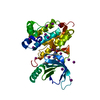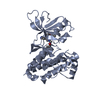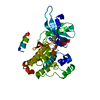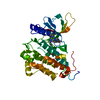Entry Database : PDB / ID : 8pnzTitle Discovery and Optimisation of Potent, Efficacious and Selective Inhibitors Targeting EGFR Exon20 Insertion Mutations. Compound 16 bound to EGFR Epidermal growth factor receptor Keywords / / / / Function / homology Function Domain/homology Component
/ / / / / / / / / / / / / / / / / / / / / / / / / / / / / / / / / / / / / / / / / / / / / / / / / / / / / / / / / / / / / / / / / / / / / / / / / / / / / / / / / / / / / / / / / / / / / / / / / / / / / / / / / / / / / / / / / / / / / / / / / / / / / / / / / / / / / / / / / / / / / Biological species Homo sapiens (human)Method / / / Resolution : 2.51 Å Authors Hargreaves, D. Funding support 1items Organization Grant number Country Not funded
Journal : J.Med.Chem. / Year : 2024Title : Discovery and Optimization of Potent, Efficacious and Selective Inhibitors Targeting EGFR Exon20 Insertion Mutations.Authors: Thomson, C. / Barton, P. / Braybrooke, E. / Colclough, N. / Dong, Z. / Evans, L. / Floc'h, N. / Guerot, C. / Hargreaves, D. / Khurana, P. / Li, S. / Li, X. / Lister, A. / McCoull, W. / ... Authors : Thomson, C. / Barton, P. / Braybrooke, E. / Colclough, N. / Dong, Z. / Evans, L. / Floc'h, N. / Guerot, C. / Hargreaves, D. / Khurana, P. / Li, S. / Li, X. / Lister, A. / McCoull, W. / McWilliams, L. / Orme, J.P. / Packer, M.J. / Swaih, A.M. / Ward, R.A. / Winlow, P. / Ye, Y. History Deposition Jul 3, 2023 Deposition site / Processing site Revision 1.0 Jun 5, 2024 Provider / Type Revision 1.1 Jun 19, 2024 Group / Category Item / _citation.page_first / _citation.page_lastRevision 1.2 Nov 6, 2024 Group / Category / pdbx_modification_feature / Item
Show all Show less
 Yorodumi
Yorodumi Open data
Open data Basic information
Basic information Components
Components Keywords
Keywords Function and homology information
Function and homology information Homo sapiens (human)
Homo sapiens (human) X-RAY DIFFRACTION /
X-RAY DIFFRACTION /  SYNCHROTRON /
SYNCHROTRON /  MOLECULAR REPLACEMENT / Resolution: 2.51 Å
MOLECULAR REPLACEMENT / Resolution: 2.51 Å  Authors
Authors Citation
Citation Journal: J.Med.Chem. / Year: 2024
Journal: J.Med.Chem. / Year: 2024 Structure visualization
Structure visualization Molmil
Molmil Jmol/JSmol
Jmol/JSmol Downloads & links
Downloads & links Download
Download 8pnz.cif.gz
8pnz.cif.gz PDBx/mmCIF format
PDBx/mmCIF format pdb8pnz.ent.gz
pdb8pnz.ent.gz PDB format
PDB format 8pnz.json.gz
8pnz.json.gz PDBx/mmJSON format
PDBx/mmJSON format Other downloads
Other downloads 8pnz_validation.pdf.gz
8pnz_validation.pdf.gz wwPDB validaton report
wwPDB validaton report 8pnz_full_validation.pdf.gz
8pnz_full_validation.pdf.gz 8pnz_validation.xml.gz
8pnz_validation.xml.gz 8pnz_validation.cif.gz
8pnz_validation.cif.gz https://data.pdbj.org/pub/pdb/validation_reports/pn/8pnz
https://data.pdbj.org/pub/pdb/validation_reports/pn/8pnz ftp://data.pdbj.org/pub/pdb/validation_reports/pn/8pnz
ftp://data.pdbj.org/pub/pdb/validation_reports/pn/8pnz




 F&H Search
F&H Search Links
Links Assembly
Assembly
 Components
Components Homo sapiens (human) / Gene: EGFR, ERBB, ERBB1, HER1 / Production host:
Homo sapiens (human) / Gene: EGFR, ERBB, ERBB1, HER1 / Production host: 
 X-RAY DIFFRACTION / Number of used crystals: 1
X-RAY DIFFRACTION / Number of used crystals: 1  Sample preparation
Sample preparation SYNCHROTRON / Site:
SYNCHROTRON / Site:  Diamond
Diamond  / Beamline: I02 / Wavelength: 0.97949 Å
/ Beamline: I02 / Wavelength: 0.97949 Å Processing
Processing MOLECULAR REPLACEMENT / Resolution: 2.51→72 Å / Cor.coef. Fo:Fc: 0.954 / Cor.coef. Fo:Fc free: 0.93 / SU R Cruickshank DPI: 0.34 / Cross valid method: THROUGHOUT / σ(F): 0 / SU R Blow DPI: 0.326 / SU Rfree Blow DPI: 0.266 / SU Rfree Cruickshank DPI: 0.274
MOLECULAR REPLACEMENT / Resolution: 2.51→72 Å / Cor.coef. Fo:Fc: 0.954 / Cor.coef. Fo:Fc free: 0.93 / SU R Cruickshank DPI: 0.34 / Cross valid method: THROUGHOUT / σ(F): 0 / SU R Blow DPI: 0.326 / SU Rfree Blow DPI: 0.266 / SU Rfree Cruickshank DPI: 0.274  Movie
Movie Controller
Controller


 PDBj
PDBj













